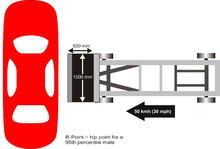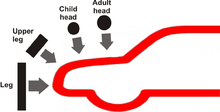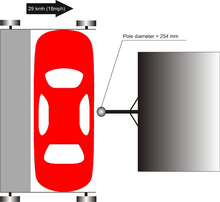STANDARDS >> REACH PACKAGING ELV BATTERIES NCAP
NCAP:
The European New Car Assessment Programme (Euro NCAP) is a European car safety performance assessment programme based in Brussels (Belgium) and founded in 1997 by the Transport Research Laboratory for the UK Department for Transport and backed by several European governments, as well as by the European Union.
History and activities:
Euro NCAP is a voluntary vehicle safety rating system which originated in the UK but is now backed by the European Commission, seven European governments, as well as motoring and consumer organisations in every EU country.
The programme is modelled after the New Car Assessment Program (NCAP), introduced 1979 by the U.S. Other areas with similar (but not identical) programmes include Australia and New Zealand with ANCAP, Latin America with Latin NCAP and China with C-NCAP.
They publish safety reports on new cars, and awards ‘star ratings’ based on the performance of the vehicles in a variety of crash tests, including front, side and pole impacts, and impacts with pedestrians.
The frontal tests are performed at 64 km/h (40 mph) into an offset deformable barrier. This is designed to represent an impact with a vehicle of similar mass and structure as the car itself. The side impact tests are performed at 50 km/h (31 mph), but the side impact pole test is performed at 29 km/h (18 mph). The pedestrian safety tests are performed at 40 km/h (25 mph).
From January 1, 2009 they adopted the rear-impact (whiplash) test as part of its new crash-test regime. This new rating system also focused more of the overall score on pedestrian protection; Euro NCAP were concerned that car manufacturers were too fixed on occupant safety rather than the safety of those outside the vehicle. Results of the first cars to be tested under the new scheme were released in February 2009.
Over the years, European automakers’ cars have become much safer, partly as a result of the Euro NCAP standards. Test results are commonly presented by motor press, and in turn greatly influence consumer demand for a vehicle.
Testing is not mandatory, with vehicle models either being independently chosen by Euro NCAP or voluntarily tested by the manufacturers. In Europe, new cars are certified as legal for sale under the Whole Vehicle Type Approval (WVTA) regimen that differs from Euro NCAP. According to Euro NCAP, “The frontal and side impact crash tests used by Euro NCAP are based on those used in European legislation. However, much higher performance requirements are used by Euro NCAP. The frontal impact speed used by Euro NCAP is 64 km/h compared 56 km/h for legislation.” Euro NCAP also states that “Legislation sets a minimum compulsory standard whilst Euro NCAP is concerned with best possible current practice.
Progress with vehicle safety legislation can be slow, particularly as all EU Member States’ views have to be taken into account. Also, once in place, legislation provides no further incentive to improve, whereas Euro NCAP provides a continuing incentive by regularly enhancing its assessment procedures to stimulate further improvements in vehicle safety.





